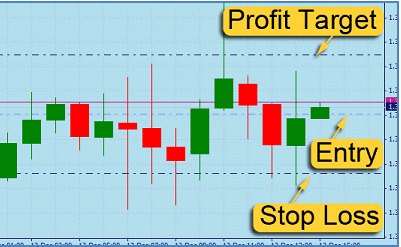Trading with the trend is trading with the flow. When the prevailing trend is up, why would you want to look for short entries when buying might result in much smoother trades? Many amateur traders, even when facing a long lasting trend that has been going on for months, can’t stop trying to predict reversals, whereas they could have made so much more money by simply joining the trend.
But even if you are not a trend-following trader, you can combine the concept of trading with the higher timeframe trend with your regular trading approach: you start on the Daily timeframe and see if the trend its up, down or sideways and you use that information on your lower, execution timeframe to time your trades (read here: how to perform a multi-timeframe analysis). To be able to correctly read price action, trends and trend direction, we will now introduce the most effective ways to analyze a chart.
Intro: The different market phases
Before we start going over how to identify the trend, we should be first clear what we are looking for. Markets can do one of three things: go up, go down, or move sideways.

The picture above shows you the three possible scenarios and how markets keep alternating between the phases. But knowing what has happened after the fact is always the easy part. The hard part is finding out what is currently happening when markets are moving in real time and the space on the right is empty – that’s where this article comes in. To be clear, the article is not meant to show you how to identify trading entries, but to understand price and trends in a more efficient way.
Continue Reading →
The benchmark BSE Sensex slumped 206 points in a see-saw trade on Wednesday to close below the 33,000-mark in the last trading session of 2017-18, but finished the year with a gain of 11.30 %.
The broader 50-share Nifty also ended 70 points lower at 10,113.70. The Sensex has gained 3,348.18 points, or 11.30 %, in 2017-18. The index had gained 16.88 % in the previous fiscal year.
Investors saw wealth addition of Rs 20.70 trillion during 2017-18. The market capitalisation of all firms listed on the BSE was at Rs 142.24 trillion against Rs 121.54 trillion as on March 31, 2017.
The broader Nifty closed the fiscal year with gains of 939.95 points, or 10.25 %. During the previous year, it scored gains of 1,435.55 points or 18.55 %.
For the day, the BSE Sensex snapped its two-session winning streak to end lower by 205.71 points, or 0.62 % at 32,968.68. Intra-day, it hovered between 33,104.11 and 32,917.66. The gauge had rallied 577.85 points in the past two sessions. The NSE Nifty, too, ended the day 70.45 points, or 0.69 % lower at 10,113.70 after shuttling between 10,158.35 and 10,096.90.
On a weekly basis, the Sensex rose 372.14 points, or 1.14 %, while the Nifty gained 115.65 points or 1.16 %. This was their first gain in five weeks.
Stock exchanges will remain closed on Thursday and Friday on account of Mahavir Jayanti and Good Friday, respectively.
Continue Reading →
A trading tool is anything that has a function that helps you be a profitable trader.
- Back testing software is a tool that helps you see what type of price action trading signals were profitable in the past price data.
- An entry signal is a tool that tells you when to get into a trade because the odds are in your favor for a winning trade.
- A stop loss is a tool that limits the size of a losing trade.
- A trailing stop locks in open profits when a trend starts to bend.
- Position size determines how big your trade should be based on market volatility.
- A profit target is a tool to measure the potential reward if your trade works out.
- Moving averages are tools for quantifying a trend.
- Passion for the markets is the powerful internal trading tool that gives you the energy to do the needed work to be a profitable trader.
- Perseverance is a psychological trading tool that keeps you going even when you want to quit.
- Self control is an internal trading tool that enables you to follow your trading system regardless of your emotions.
Your greatest trading tools are going to be perseverance and self control. These are the only things that will buy you the time to learn how to build a profitable trading system, and once you have developed a system that works to then follow it long term.
This article was written by Steve of newtraderu.com and can be found here.
A profitable stock trader’s success is not based on picking the right stock at the right time. There are dynamics that determine success other than entries and picks. Millionaires aren’t created because they have a magic system for trading through all market environments. There are a couple of things that influence profitable trading, and they could surprise you.
#1. Having the right mindset to win; psychology.
#2. Managing your risk exposure on each trade; risk management.
No system will work if you can’t trade it consistently. You must stick to your method when you are losing. Whether it’s to keep taking entries, to go to the sidelines and wait for volatility, or to settle down and wait for a trend to emerge.
You must stay in the game and be ready to take your entry signals. The primary reason that traders lose money is that they give up when things get tough because they don’t have faith in their system. A trader must persevere, never quit learning, never quit working, and always be ready to trade.
Continue Reading →

Lemon Tree Hotels Ltd. (LTHL) is India’s largest hotel chain in the mid-priced hotel sector, and the third largest overall, on the basis of controlling interest in owned and leased rooms, as of June 30, 2017, according to the Horwath Report. It is the ninth largest hotel chain in India in terms of owned, leased and managed rooms, as of June 30, 2017, according to the Horwath Report. LTHL operates in the mid-priced hotel sector, consisting of the upper-midscale, midscale and economy hotel segments. Company seeks to cater to Indian middle class guests and deliver differentiated yet superior service offerings, with a value-for-money proposition. The company opened our first hotel with 49 rooms in May 2004 and as on 31.01.2018 it had 4,697 rooms in 45 hotels (including managed hotels) across 28 cities in India. On the said date it has 662992 members in loyalty programme as “Lemon Tree Smiles” and the number is continuously rising.
LTHL aims to be India’s largest and most preferred chain of hotels and resorts in each of the upper-midscale, midscale and economy hotel segments. Due to the dynamic and evolving nature of Indian guests’ expectations and based on its market research, company has created three brands in order to address these three hotel segments: (1) ‘‘Lemon Tree Premier’ which is targeted primarily at the upper-midscale hotel segment catering to business and leisure guests who seek to use hotels at strategic locations and are willing to pay for premium service and hotel properties; (2) “Lemon Tree Hotels” which is targeted primarily at the midscale hotel segment catering to business and leisure guests and offers a comfortable, cost-effective and convenient experience; and (3) “Red Fox by Lemon Tree Hotels” which is targeted primarily at the economy hotel segment.
Continue Reading →
The BSE Sensex plunged by about 410 points to close at a five-month low while the broader Nifty crashed below the 10,000 mark for the first time this year following a global sell-off due to fears of a trade war as US President Donald Trump announced tariffs on Chinese goods.
The 30-share Sensex tumbled by 409.73 points or 1.24 per cent to close at a five-month low of 32,596.54, a level last seen on October 23 last year.
The 50-issue Nifty ended below the psychological 10,000-level by dropping 116.70 points or 1.15 per cent to 9,998.05, the lowest closing level in five months. The level was last seen on October 11 last year, when it had closed at 9,984.80.
Investors lost around Rs 1.57 trillion in market valuation on Friday.
For the fourth straight week, the flagship Sensex recorded a fall of 579.46 points, or 1.75 per cent, while the NSE Nifty lost 197.10 points, or 1.93 per cent.
Realty, metal, bankex, capital goods, healthcare, PSU, auto and oil & gas stocks recorded widespread losses.
Continue Reading →

Verdict: I C it as an expensive Security
IPO Snapshot:
ICICI Securities is entering the primary market on Thursday 22nd March 2018, with an offer for sale (OFS) of up to 7.82 crore equity shares of Rs. 5 each by promoter ICICI Bank, in the price band of Rs. 519 to Rs. 520 per share. Representing 23.98% of the post issue paid-up share capital, ICICI Bank will rake in Rs. 4,017 crore at the upper end of the price band, which will help it partly off-set higher loss provisions. Issue is closing on Monday 26th March and listing is likely on 5th April.
Company Overview:
ICICI Securities, a wholly owned capital market arm of ICICI Bank, offers broking (through ICICIdirect.com), investment banking, portfolio management services (PMS) and financial products distribution (mutual fund and insurance) to retail and institutional customers, through its marketing network of 200 own branches, 2,600+ branches of ICICI Bank, 4,600+ sub-brokers and independent financial associates. The technology, whether broking or mutual fund distribution is a ‘me-too’ or easily replicable, and most other full-fledged broking firms like Motilal Oswal or a discount broker such as Zerodha or many fin-tech start-ups in mutual fund distribution have similar offerings. Hence, its technological capabilities are not out-of-the-world and are simply keeping up with the changing times. Approximately 60% of income is generated through broking, 10% from investment banking, 15% from mutual fund distribution and balance through distribution fee of insurance and other products.
Continue Reading →
 Legendary investor Warren Buffet laid the ground rules for investment philosophy when he set two rules for investing. Rule Number 1 of investing according to Buffet is never losing money and Rule Number 2 is Don’t forget Rule Number 1.
Legendary investor Warren Buffet laid the ground rules for investment philosophy when he set two rules for investing. Rule Number 1 of investing according to Buffet is never losing money and Rule Number 2 is Don’t forget Rule Number 1.
But that is easier said than done, especially for a retail investor or a novice investor. In order not to lose money in the market is to pick up stocks which are close to the bottom. No fund manager, not even Warren Buffet has been consistently able to pick the bottom. But what differentiates a professional to a rookie is the ability to patiently wait and stick to their well-defined set of rules. It is not important to pick the bottom to make money, but as far as the price is right all that is needed to sit on the investment and patiently watch it grow. As the saying goes in the market it is not the brain that brings home the profit but its stomach to hold through the times.
Continue Reading →

Verdict: Healthy LT prospects, but not for ST
IPO Snapshot:
Mishra Dhatu Nigam is entering the primary market on Wednesday 21st March 2018 with an offer for sale of up to 4.87 crore equity shares of Rs. 10 each, by the Govt. of India, in the price band of Rs. 87 to Rs. 90 per share, with Rs. 3 per share retail discount. Representing 26% of the post issue paid-up share capital, total issue size is Rs. 433 crore at the upper end of the price band. The issue is closing on Friday 23rd March and listing is likely on 4th April.
Company Overview:
Mishra Dhatu Nigam (Midhani), a wholly owned subsidiary of the Govt. of India, is India’s leading manufacturer of special steels and super alloys and the country’s sole manufacturer of titanium alloys, used in three critical sectors such as defence, space and nuclear energy, as well as in non-strategic sectors such as railways, oil and gas among others. Company has a manufacturing facility at Hyderabad and is undertaking greenfield expansion at two locations (i) Rohtak: operations to commence in FY19, to cater to needs of bullet proof jacket for the army and (ii) Nellore: plant will be operational in two phases – first part to commence in FY19-end, while second phase is under JV with NALCO will come on stream by FY21/22.
Continue Reading →

A profit vs loss ratio is something that can by itself help you succeed investing in the stock market. They work wonders for new traders and are used by professionals as well.
This article will explain what a profit vs loss ratio is, how to set one up, and how to stay disciplined to utilize it effectively.
What They Are
A profit vs loss ratio is a plan that you put in place to limit your downside exposure on all your trades to x% while setting a target on your upside to x% return per trade. Depending on how you setup your ratio, you can be wrong more than you are right and still make money in your portfolio.
The whole point of your profit vs loss ratio is to be able to say, “hey, even if I am wrong x times in a row and then am right once, I still am making money”.
How to Setup Your Ratio
There are 2 factors to any ratio: maximum loss % per trade, and your target profit % per trade. Once you know these you know your ratio.
Continue Reading →









 Legendary investor Warren Buffet laid the ground rules for investment philosophy when he set two rules for investing. Rule Number 1 of investing according to Buffet is never losing money and Rule Number 2 is Don’t forget Rule Number 1.
Legendary investor Warren Buffet laid the ground rules for investment philosophy when he set two rules for investing. Rule Number 1 of investing according to Buffet is never losing money and Rule Number 2 is Don’t forget Rule Number 1.
